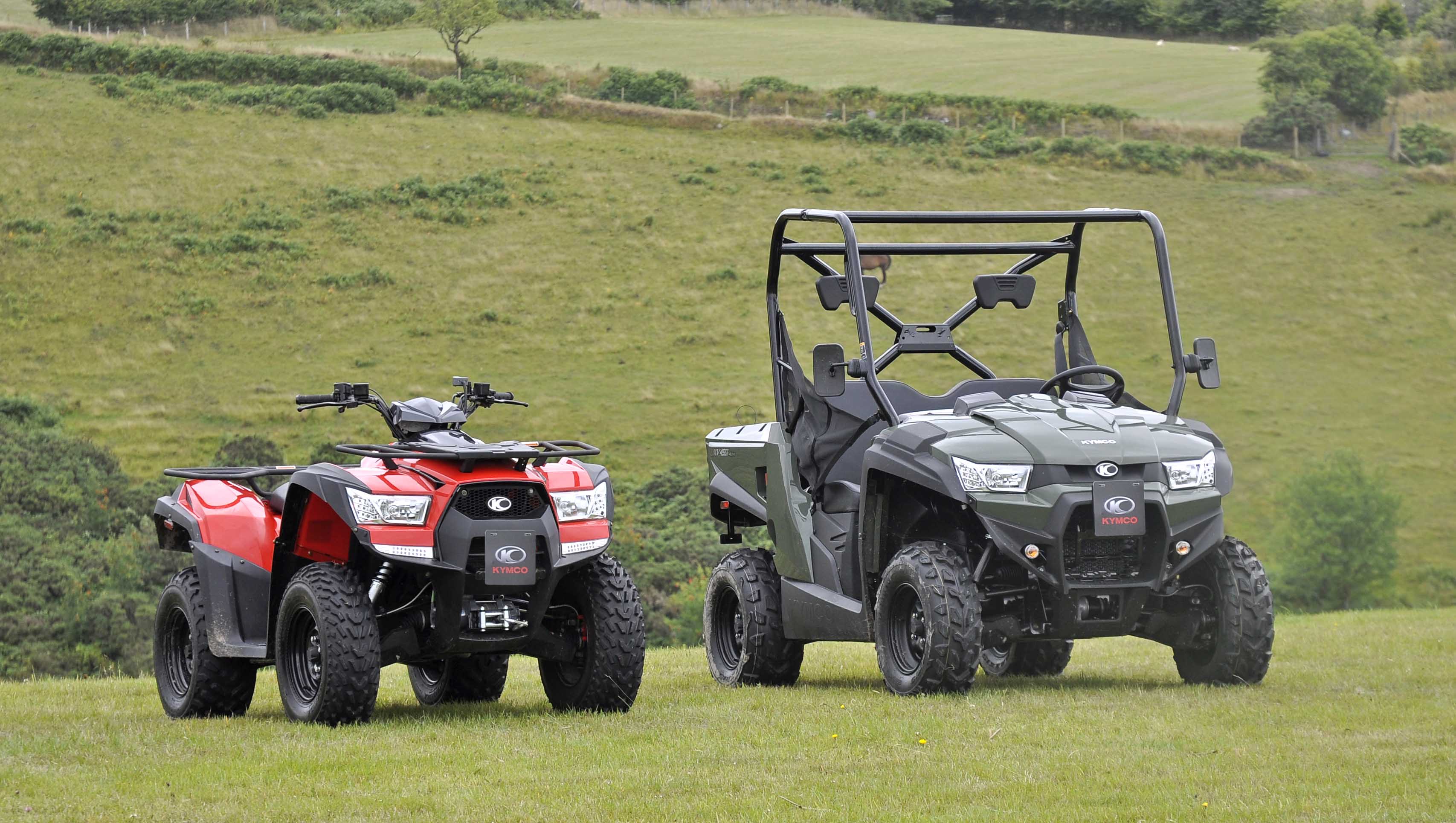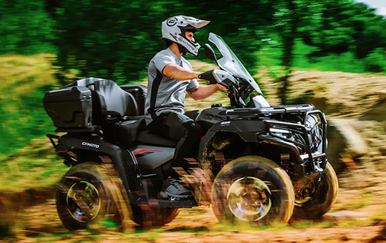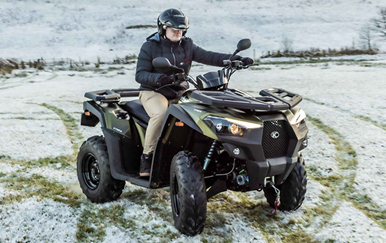All your questions answered!
Thinking of getting a quad bike and want to know the basics? Or maybe you have one already, and want to double check a few things before you head out on it. Either way these quick FAQs will go over the main points for you.
I’ll link relevant articles throughout so that you can find out more in-depth information about certain topics.
If you feel like there is anything missed out, or if you have a question about anything quad or ATV related, let us know on social media, comment below, or give us a call – 01379 646 504.

What licence do I need to ride a quad bike in the UK?
At minimum, to ride a road-legal quad (or ATV) on the road, you will need a full UK car driving licence (category B or B1).
Although most quads will have handlebars & controls fairly similar to a motorcycle, unless your motorcycle licence has a B1 entitlement you’ll need a car licence.
Of course, riding on privately owned land doesn’t require a licence at all – just the land owners permission!
How does insurance work for a quad or ATV/buggy?
Quads & ATVs are looked at in the eyes of the law similar to cars. So to have one legally on the road, amongst other things, you'll need road specific insurance cover. Often, to insure quad bikes, most insurers will request that you are 21 & over. Although this can vary between insurers, so before you purchase it with intent for riding on the road, check you can insure your quad – as you’ll need valid insurance to be properly covered.
What insurance do I need to ride a quad?
If your quad is road legal, at minimum in the UK you will need Third Party Only (TPO) insurance cover. This is the same with all vehicles on the road, and ensures that you are insured in case of an accident to cover the third party, only, if there is someone else involved in your accident. Our insurance policies for quad bikes will also allow you to cover your quad or ATV at Third Party Fire & Theft (TPFT), and Fully Comprehensive levels.
Are quad bikes road legal? Can you make a quad bike road legal?
A road legal quad must have, at minimum: a front and rear numberplate, be road registered, taxed & hold a valid MOT (if over 3 years old) as well as being insured for road use. A daytime MOT can be granted for quads without front or rear lights, but in the interest of safety we would always recommend using a quad on the road that has working lights & indicators.
If you’re making your quad road legal, you can submit it for ‘type approval’ to get it road legal – but it’s a lot easier to get a quad that is already road legal, rather than customising it for this purpose.
Can you ride a quad without a helmet? What is the best protective gear for a beginner?
You are not legally required to wear a helmet on a quad bike, but we would absolutely recommend doing so. A quad can travel on the road at a good speed, and wearing a helmet on a motorcycle is mandatory for a reason – safety. Whilst on the topic, we would also recommend wearing as much protective gear as possible – such as gloves, boots, chest-plate, & protective jeans. You can get varying levels of protective gear, particularly if you’re going to be out in different season – winter gear may not be ideal in summer, for example.
Can you ride a quad bike for long distances?
You definitely can, although after a while you may get tired! Riding a quad bike is loads of fun, but it’s also quite a workout. If you’re planning on taking a quad bike on a long journey, think about the route – whilst you can go 60mph on a quad, it won’t be too fun flat out for hundreds of miles.
What are the different types of quad bikes?
Quads and ATVs come in all sorts of shapes & sizes, but they are broken down into groups:
- Sports (like the Yamaha Raptor)
- Utility (like the Honda FourTrax)
- and Agricultural ATVs.
They are all good at different tasks, so if you’re thinking of getting your first quad, think about what you’ll use it for the most.
Where to MOT and service quad bikes?
A lot of motorcycle garages will often have services they can provide for quad bikes & ATVs, but if in doubt about what is in your local area, we recommend checking online forums and groups – or asking your local dealership.
How to ride a quad bike - do you need experience or a test?
Riding a quad bike is not a million miles off from a motorcycle, except you will usually have a thumb throttle. It varies between quads, but some are manual (often sports quads) with a hand clutch & foot controlled gears – just like a motorcycle.
Others are automatic with a hand controlled shifter. It really does vary from manufacturer to manufacturer. No testing or experience is necessary, the entitlement is gained through a driving test.
Where to ride quad bikes - can you quads on green lanes, tracks or off-road?
Of course, with the land owners permission, you can ride any vehicle on private land – obviously you’ll want to check your personal insurance cover to make sure that’s okay. Quads that are road legal can be ridden anywhere on roads, where vehicles with four wheels are allowed (so no bike lanes!).
Roads in between, like green lanes and tracks, are legal to drive down, but you’ll have to be sensible and check online to make sure your planned route is legal to drive your vehicle down!
Remember that a road classed as “public right of way” can be ridden down, but you’ll still need a full car licence or B1 licence entitlement, as well as the vehicle being road legal/registered, taxed, with a valid MOT and road insurance (not off-road only cover). They are still public roads, after all.
When it comes to tracks or off-road, a lot of motocross tracks won't actually allow quads, unless otherwise noticed. So check before you turn up at a track.
Can I carry passengers with a quad or ATV?
If the quad or ATV is built to carry a passenger (it says in the manual usually), and you have the adequate cover & protection, then yes – you can carry a passenger. Some ATVs are side-by-side seats, which can seat up to 3 people. But check the owners manual to find out for sure, and make sure you have adequate insurance to carry a passenger.
ATV and buggy alternatives
When you think of a quad, you’ll think of the standard utility quad most likely – which serves a broad range of purposes, and is basically the jack of all trades.
A utility quad is good for comfort when driving whilst carrying things on the often present front & rear racks, or hauling things on an attached trailer… but you’ll also have purpose built agricultural quads for these uses. Winches may come as an option on some utility quads, but can be fitted on most for further utility uses.
Sports quads are the best choice (or most popular) for those looking for leisure use on road & off-road, whilst side-by-side ATVs and buggies provide the best utility and comfort uses. It really depends what you’re after as to what is the best!
Farming quads - Why are quads used for agriculture?
If you are wondering why quads are so common in agricultural, forestry and off-road uses, it is simply because of their power & versatility. Whilst still being fairly small (compared to other off-road vehicles) they allow the rider to power through multiple terrain types, hence the name, All-Terrain-Vehicle. Whether it’s to carry equipment around, or haul a trailer, ATVs or quads are often the perfect option for using on and off road, at a decent price.
Popular quad bikes
If you want a full list of popular quad bikes, you can check our great quad bikes for beginners and 10 of the best road legal quads blogs - but some starting classics are: Yamaha Raptor, Yamaha Banshee, Honda FourTrax – plus quads & ATVs from Polaris, John Deere, Quadzilla, Kymco, & Can-Am.
Insurance for quad bikes
Lexham Insurance can provide quotes for on-road & & ATV insurance.









